Googling “what to do if my dog is aggressive?” and still not getting the results you desperately wanted? I have a mind-blowing secret that's made many dog owners say “I CAN'T BELIEVE THIS IS POSSIBLE!”
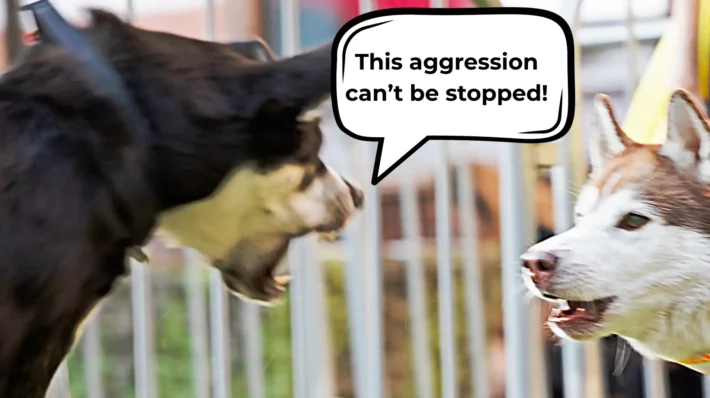
A dog's aggression toward people and other animals is one of the biggest reasons shelter dogs get sent back to their rescue facility. Aggression is also a reason some people dump their rescue dogs on the side of the road again.
It's unfortunate how a large percentage of rescue dogs get abandoned eventually. It doesn't help that some shelters aren't 100% straightforward about the needs and behavioral issues of some dogs. This is why it's vital to go for a reputable shelter with quality staff and excellent reviews if you're going to rescue a dog.
But what happens if you end up taking a dog home that has aggressive tendencies? Is all hope lost? Definitely not!
All dogs have the ability to change. You just have to be willing to spend the time and effort to help your dog overcome their aggressive tendencies.
How can you help a dog that is aggressive to everyone at home? Here are my thoughts…
Key Takeaways:
- Figure out why your dog is acting aggressively. Is it just around other dogs at the dog park? Are they scared or anxious? Or do they think they're the boss? Knowing the reason behind the aggression is the first big step in helping them.
- Training is key to making them feel safe and secure. The main idea is that consistent training helps your dog learn to trust you and feel like you've got things under control. This makes them less likely to feel they need to be aggressive to protect themselves or their stuff.
- Think about safety, especially with kids or other pets, and know your limits. While it's great to want to help, it's really important to be realistic about the risks. If it's too dangerous — or if your dog has a bite history — there are other options like getting help from the shelter or a professional, or even finding a safer home for the dog.
A Quick Disclaimer Before We Get Started
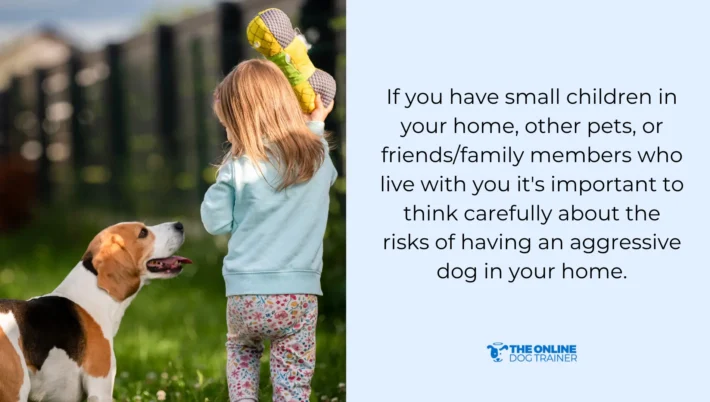
Before we get too far, I can't stress enough that adopting a dog with aggressive tendencies is a huge undertaking and can be dangerous.
While I know all dogs can be good dogs and that it is possible to help any dog overcome aggressive habits, dogs are powerful animals, and there are risks associated with trying to manage this type of behavior.
If you have small children in your home, other pets, or friends/family members who live with you, it's important to think carefully about the risks of having an aggressive dog in your home. It may even be best to seek alternative options to ensure everyone in your household remains safe.
I'll discuss some alternative options at the end of this article, so keep reading to find out what I recommend!
However, if you can house a dog with aggressive tendencies and are willing to put in the work to help your new canine companion thrive, let's get into the meat and potatoes of how to help your dog.
Understanding Your Rescue Dog's Behavior and Aggression Type
Believe it or not, there are different categories of aggression that your rescue dog might be dealing with. It's important to first identify which type your dog struggles with so you can get to the root of the issue.
Dog-on-Dog Aggression or Acting Aggressive With Another Dog
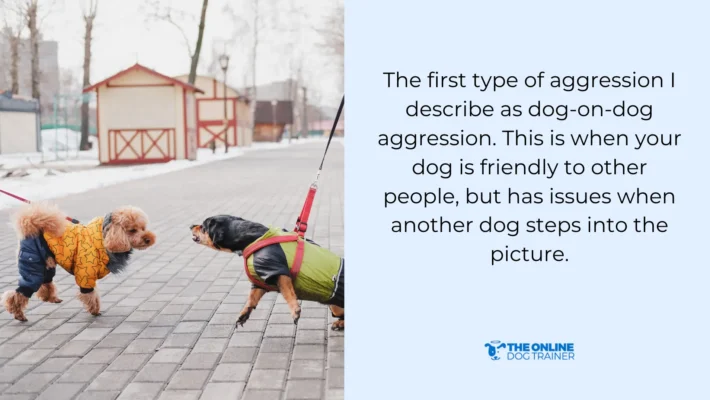
The first type of aggression I'm going to describe is dog-on-dog aggression. This is when your dog is friendly to other people, but has issues when another dog steps into the picture.
For example, your dog might be a cuddly love-bucket at home, but the second you go to the dog parks and see other dogs, your pup starts barking, growling, and trying to go after other dogs.
This scenario can also happen with dogs at home.
Unaltered male dogs may also display aggression toward other males, sometimes even engaging in fights. This can occur both when they encounter new male dogs and within a household where multiple males live together.
Why does this happen? Is it safe to have such dogs at home with this problem? And how do you put an end to it for good? A little while back I wrote a detailed article on how to put an end to dog-on-dog aggression in your home.
Learn more about dog-on-dog aggression here!
Fear and Protective Aggression
Fear aggression occurs when a dog is fearful, suffers from anxiety, feels terrified of unknown dogs, or feels threatened. This is very common amongst shelter dogs who come from abusive situations.
Put yourself in your dog's paws…
A dog's only way to protect themselves from perceived threat is with their voice, their teeth, and their claws. A fearful and protective dog will use defensive aggression to protect you, the young (kids and other young dogs), and the property.
How do you help your new rescue dog understand that they no longer have to be defensive and fearful? It all comes down to training, which builds a trusting bond between you and your dog.
I've written on the topic of fear aggression several times as it's a huge issue. To best assist you with working on this type of aggression, I want to point you to an article that contains a really cool training video I filmed with a fearful dog named Buck.
Watch the video and learn how to manage fear aggression here!
END THE DAILY STRUGGLE—JOIN THE FREE WEBCLASS THAT CALMS REACTIVE DOGS IN JUST 7 DAYS
Dominance-Based Aggression
Finally, it's possible that your dog is suffering from dominance-based aggression.
This type of aggression occurs when a dog behaves aggressively because they believe that they are at the top of the hierarchy…that they are the leader of the pack, so to speak. They make the rules and if you or another dog doesn't fall in line with their wishes, they show an aggressive display to reinforce dominance. Dog fights usually start when a dominant dog needs to reassert their place in the hierarchy.
If you believe your rescue dog has dominance-based aggression, I encourage you to read more about this specific type of aggression in an article I wrote recently…
Learn more about dominance-based aggression here!
Predatory Aggression
Predatory aggression in dogs is an instinctive hunting behavior, not a sign of malice or anger. It's a silent, focused sequence of predatory behavior —stalking, chasing, and grabbing prey — that lacks the usual warnings like growling. This drive is a remnant of their wolf ancestry and is often strongest in breeds originally developed for hunting or herding.
To manage it, it's crucial to prevent the dog from rehearsing the behavior by keeping them on a leash and avoiding triggers. Training should focus on impulse control and providing safe outlets for this energy, like using a flirt pole or playing fetch. By understanding this instinct, owners can manage it safely and effectively.
Possessive Aggression
Possessive aggression, also known as resource guarding, is a common and natural behavior in which a dog protects items they consider valuable from being taken away by people or other animals. These “resources” can be anything from food and chews to toys, beds, or even a favorite person.
The motivation for this aggressive reaction is often rooted in fear or anxiety—the dog is worried about losing something it values, not necessarily trying to be “dominant” or malicious.
The Ultimate Solution to Helping Rescue Dogs with Aggressive Behaviors
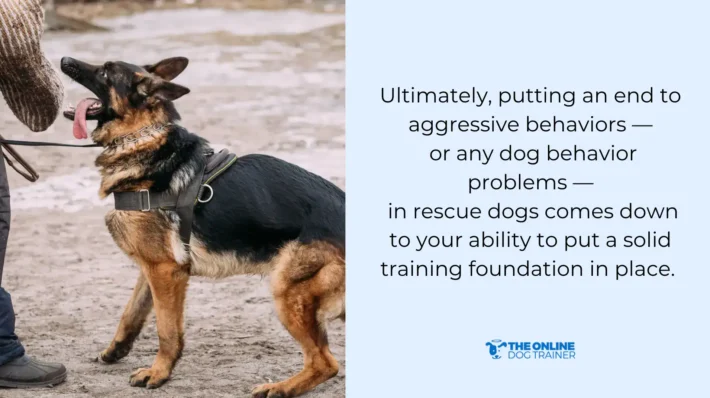
Ultimately, putting an end to aggressive behaviors — or any dog behavior problems — in rescue dogs comes down to your ability to put a solid training foundation in place.
Why?
When you put a training program in place — like my program The Dog Calming Code — your dog learns to relax, focus, and trust you as the provider. Once this relationship is established, the pressure for your dog to have to use aggressive tactics to defend themselves, protect their things, etc. disappears.
Instead of lunging, biting, and growling, your dog will look to YOU for guidance and reassurance—regardless of whether they suffered from fear-based aggression, dog-on-dog aggression, or dominance-based aggression.
You have to remain dedicated to the process in order for it to work. While this might seem daunting, it's really as simple as following some basic rules and keeping your dog on a routine.
If you feel overwhelmed by the idea of implementing a training program, I encourage you to take a look at my Dog Calming Code program.
In this program, I lay out everything you need to know, including 23 training videos that literally show you HOW to do everything step-by-step in real time!
Best of all, I also cover many other issues such as barking, separation anxiety, jumping, leash pulling, etc., so you have everything you need regardless of what other issues your pup might struggle with.
Learn more about The Dog Calming Code here!
A Few Final Thoughts on Alternative Solutions

Like I just mentioned above, I know that any dog with any level of aggression can change and become a wonderful companion…especially when you put a program like The Dog Calming Code in place.
However, there are other factors and risks to consider when bringing an aggressive dog into your home— especially if you have other pets and small children.
Pet parents, if an aggressive dog is putting anyone in your home at risk and you don't have the space or time necessary to fix the behavior please consider the following options…
Reach Out To The Shelter You Rescued From
If your dog shows aggression, don't simply drop them back off at the shelter. Call the shelter to see if they offer any resources for you. Let them know your issues and concerns. They might have resources to help you.
At the very least, try and make arrangements with them to find a foster home with someone who can manage the dog, train the dog, and rehome the dog when the aggression issues have been taken care of.
Hire A Kind, Gentle, And Experienced Professional Dog Trainer
I know my program will give you everything you need to succeed while training an aggressive dog. However, if you're feeling overwhelmed it's sometimes helpful to have someone come into your home and lend you a hand. Over the years I've taught many dog trainers my methods and have certified Dog Trainer Academy students all around the world! If you're struggling, get in touch with me and I'll do my best to see if I can find a DTA certified trainer in your area!
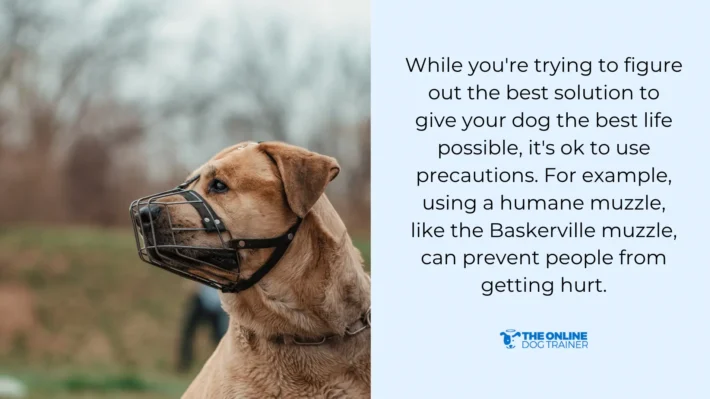
Take Precautions Until You Can Find A Suitable Home For Your Dog
While you're trying to figure out the best solution to give your dog the best life possible, it's ok to use precautions. For example, using a humane muzzle, like the Baskerville muzzle, can prevent people from getting hurt. Or, separating your dog into a room by himself can prohibit a child or another pet from accidentally getting hurt. You also have to be aware of the warning signs and your dog's potential triggers.
As long as your dog is in a safe space and has access to food and water, they will be ok!
Bringing home an aggressive rescue dog has its challenges, but I've seen far more happy endings for these dogs than sad ones when an owner is dedicated to solving the root of the problem.
I wish you the best with your rescue pup and thanks for adopting instead of shopping!
Cheers,
Doggy Dan
Frequently Asked Questions
This FAQ addresses common questions about aggressive dog behaviour and what you can do about it. Understanding your dog's behavior is the first step towards a happier and safer environment for everyone.
Q: Why does my dog react aggressively sometimes?
A: There are many reasons why a dog reacts aggressively. Most dogs react aggressively due to fear, pain, or even learned behavior. Sometimes, if a dog is frustrated by something they can't get, like another dog behind a fence, they might exhibit redirected aggression towards a nearby person or another animal.
GET YOUR LIFE BACK—LEARN HOW 100,000 OWNERS CALMED THEIR DOG IN OUR FREE WEBCLASSQ: What are some common reasons for dog aggression?
A: Some common types of aggression in dogs include territorial behavior, where a dog protects their space, resources (like food), or even a person. Fear can also trigger an aggressive response if a dog feels threatened. In some cases, even excitement can lead to nipping or biting. An injured dog can also exhibit pain-elicited aggression and frustration-elicited aggression.
Q: Is there such a thing as a “bad” breed that is inherently aggressive?
A: While breed type can sometimes influence certain tendencies, it's important factor to remember that a dog's behavior is largely shaped by their upbringing, training, and individual experiences. There is no such thing as an inherently “bad” breed.
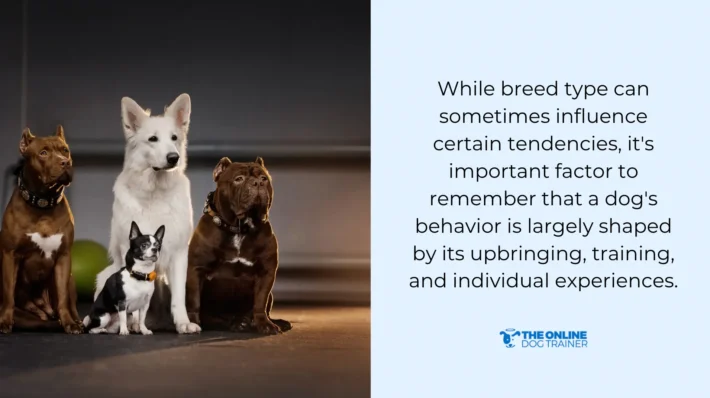
Q: How can I tell if my dog is going to act aggressively?
A: Learning to read your dog's body language is crucial. Subtle signs like stiffening, lip curling, showing teeth, or a hard stare can indicate that your dog is feeling uncomfortable and might react. Barking can also be a sign of arousal, which can sometimes escalate into aggression.
Q: What should I do if my dog acts aggressively?
A: If your dog is acting aggressive, it's crucial to prioritize safety. Avoid situations that trigger the behavior and maintain a safe distance from whatever is causing the reaction. Never use punishment, as this can make the fear and aggression worse. Consulting with a veterinarian and a qualified behavior professional is highly recommended.
Q: Can obedience training help with an aggressive dog?
A: While obedience training is beneficial for all dogs, it might not directly address the root cause of aggression. However, it can provide you with better control over your dog through commands like “sit” and “stay,” which can be helpful in managing situations. For aggressive behavior, behavior modification techniques are usually necessary.
ACCESS THE PROGRAM THAT HAS HELPED 100,000 DOGS CHANGE FOR FREEQ: What is behavior modification for dogs?
A: Behavior modification involves identifying the triggers for your dog's aggression and then systematically working to change their emotional response. This often involves techniques like counter conditioning, where you pair the trigger with something positive, like a high-value treat, to create positive experiences.
Q: How does counter conditioning work?
A: Counter conditioning aims to change your dog's association with a trigger from negative to positive. For example, if your dog reacts aggressively to other dogs, you might start at a distance where your dog remains calm and give them a treat every time another dog appears. The goal is for your dog to start associating the presence of other dogs with something good.

Q: Are head halters useful for aggressive dogs?
A: Head halters can provide you with more control over your dog's head movement, which can be helpful in redirecting their attention and preventing lunging. However, they are a management tool and not a solution for the underlying aggression. They should be used with positive reinforcement and proper introduction.
Q: Is regular exercise important for managing dog aggression?
A: Regular exercise is crucial for the overall well-being of your dog. A tired dog is often a calmer dog. Ensuring your dog gets enough physical and mental stimulation can help reduce overall arousal levels, which may indirectly help in reducing aggression.
Q: What if my dog's aggression seems directed at me?
A: Aggression towards humans in the household can be complex. It's essential to consult with a qualified behavior professional immediately to assess the situation and develop a behavior modification plan. Never try to handle this type of aggression on your own without professional guidance.
Q: How do dogs learn?
A: Dogs learn through association, consequences, and repetition. They are more likely to repeat behaviors that are rewarded and avoid behaviors that lead to unpleasant outcomes. This is why positive reinforcement, using things like treats and praise, is generally more effective than punishment in training.
Q: My dog used to be friendly but is now acting aggressively towards our new dog. Why?
A: Introducing a new dog can sometimes disrupt the existing social dynamics in a household. Your current dog might be displaying territorial behavior or feeling insecure about the new addition. Gradual and careful introductions are crucial, and sometimes professional guidance is needed to help one dog adjust to the presence of another. Just because two dogs live in the same house doesn't automatically mean they will become best friends.

~Doggy Dan 🙂







25 Responses
Thank you for sharing these insights! It’s so helpful to have concrete strategies for dealing with aggression in rescue dogs. I appreciate the emphasis on understanding their past and being patient. Looking forward to Part 3!
You’re welcome
Thank you for sharing these valuable insights! It’s so important to address aggressive behaviors in rescue dogs, and your step-by-step guidance makes it feel manageable. I’m looking forward to applying these techniques with my dog. Can’t wait for Part 3!
You’re welcome! There’s much more help inside the membership. Check it out here https://theonlinedogtrainer.com/shop/#best-seller
“I can totally relate! My dog, Charlie, has also been showing signs of aggression, and it’s been such a struggle to find effective training methods. I’m really hopeful that the advice in this post will help us make progress and give him the peaceful life he deserves. Thanks for sharing these valuable insights!”
You’re welcome. Check my website for lots more https://www.theonlinedogtrainer.com
Loved this post! As someone who recently adopted a rescue dog, it’s been a struggle to deal with her aggressive behaviors. Your tips on recognizing and addressing triggers really resonated with me. Can’t wait to give the ‘leave it’ command a try!
Great stuff!
Just finished reading this post and I’m blown away by the progress you’ve made with these rescue dogs! I’ve been struggling with my own rescue pup’s aggressive behavior and your advice has given me new hope. Thank you for sharing your expertise and experience – it’s truly inspiring!
You’re very welcome!
I found this post to be incredibly informative and helpful. As someone who has recently adopted a rescue dog with aggressive tendencies, I was amazed at the variety of techniques and strategies you provided. Thank you for sharing your expertise and experience, I can’t wait to start working with my dog to address these issues and strengthen our bond. Please continue to share more insights and tips in future posts!
You’re welcome!
Great article! I recently adopted a rescue dog with a history of aggression, and I’m finding it challenging to manage his behavior. I’m so glad to see that there are effective techniques and strategies out there to help me address this issue. I’m looking forward to trying out the methods you’ve shared in this post. Thank you for sharing your expertise and helping us rescue dog parents navigate these complex behaviors!
You’re welcome! There’s loads more on my website http://theonlinedogtrainer.com
Loved this article! My rescue dog, Max, has been exhibiting aggressive behaviors towards other dogs and people, so I’m so glad I found this series. This post provides such helpful tips and insights. Can’t wait to try out the techniques and see the positive impact on Max’s behavior. Thank you for sharing your expertise!
You’re welcome! There’s a lot more at my website http://theonlinedogtrainer.com
I completely agree! My rescue dog, Max, has also shown signs of aggression, especially towards other dogs. It’s been a challenge to train him, but I’m glad to see there are resources available to help. I’ll definitely be trying some of the techniques mentioned in this post. Thanks for sharing!
You’re welcome
I completely agree that addressing the root cause of aggressive behaviors is key to resolving them in dogs. As someone who has worked with rescue dogs before, I’ve seen firsthand how important it is to understand their past experiences and traumas in order to help them overcome their aggression. Great post!
Love this series! My rescue dog, Max, has been exhibiting aggressive behaviors towards other dogs and people, and I’m desperate for help. I’ve tried different training methods, but nothing seems to be working. Hoping the tips in this post will help me finally address these issues and give Max the happy, well-adjusted life he deserves. Thanks for sharing your expertise!
You’re welcome
Great post! I’m definitely experiencing some of the issues you mentioned in my own rescue dog, Jax. He’s a lovable goofball but can be quite reactive and aggressive at times, especially towards other dogs. I’m excited to try some of the techniques you shared in this post to help him feel more calm and secure. Thank you for sharing your expertise!
You’re welcome
This is a great series on rescue dogs! I’m looking forward to learning more about how to help them overcome aggressive behaviors and create a happy, healthy home for both the dog and their family.
The most important step in correcting this behaviour is to understand WHY your dog is not relaxed around other dogs. Very often this is to do with them being stressed because of the role that they are playing and when you are able to communicate to them that they can switch off and relax, everything changes and is a lot easier.
Here is a link to a blog post that explains more about dog aggression:
http://theonlinedogtrainer.com/the-ultimate-guide-to-dealing-with-dangerous-dog-aggression-issues/
You would also benefit from a comprehensive training program as soon as possible. These can be found at TheOnlineDogTrainer.com for as little as $97USD.
All the best, Dan